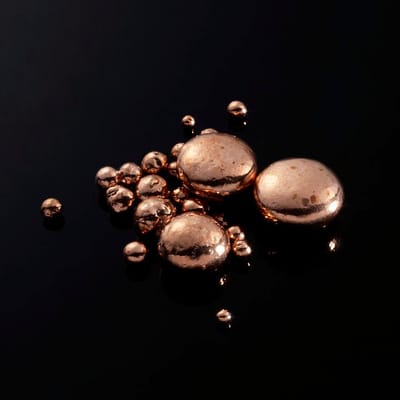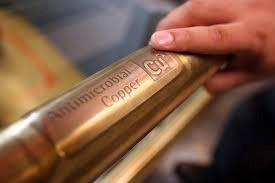The Science
Studies have shown that Copper(Cu) can kill several infectious viruses such as bronchitis virus, poliovirus, human immunodeficiency virus type 1(HIV-1), E. Coli, MRSA and Influenza A, other enveloped or none enveloped, single- or double-stranded DNA and RNA viruses on contact in a short time.
The newest research published in New England Journal of Medicine proved that copper is effective against SARS-CoV-2, we are talking about virus that is responsible for covid-19 global pandemic.
Recently, the strong antimicrobial effect of copper against methicillin-resistant S. aureus, multidrug-resistant Pseudomonas aeruginosa, and E. coli was revealed, which indicated the strong potential of copper for infection control including that of antimicrobial-resistant bacteria in the medical field. Antiviral effect of copper was reported in norovirus, influenza virus, and SARS-CoV-2. Bacteria infected hands create a great environment for virus replication.
Antimicrobial copper acts as an inhibitor of virus RNA replication and stops the virus from surviving. Lab research showed ‘anti-microbial copper’ deactivated virus cells within minutes of contact with the surface.
How does copper affect bacteria?
Scientific research shows that there are two sequential steps that copper infused surfaces affect bacteria and viruses:
1- the first step is a direct interaction between the surface and the bacterial or viral outer membrane, causing the membrane to rupture
2- The second step is related to outer membrane holes in bacteria and virus. Through those holes cell loses its vital nutrients and water which leads to weakening and final destruction of the cell.
How can copper punch holes in a bacterium?
Every cell's outer membrane, including that of a single cell organism like a bacterium, is characterized by a stable electrical micro-current. This is often called "transmembrane potential" and is, literally, a voltage difference between the inside and the outside of a cell. It is strongly suspected that when a bacterium comes in contact with a copper surface, a short circuiting of the current in the cell membrane can occur.
This weakens the membrane and creates holes. Another way to make a hole in a membrane is by localized oxidation. This happens when a single copper molecule,
or copper ion, is released from the copper surface and hits a building block of the cell membrane (either a protein or a fatty acid). If the "punch" occurs in the presence of oxygen, we speak of oxidative damage.
After punching holes, how do copper ions further damage the cell?
As the cells main defense (its outer membrane) has been breached, copper ions can stream right into the cell. Copper takes over the inside of the cell and obstructs cell metabolism (i.e., the biochemical reactions needed for life). These reactions are accomplished and catalyzed by enzymes. When copper binds to these enzymes, their activity ends. The bacteria or virus can no longer breathe, eat, digest, or create energy.
How can copper's effect be so fast, and affect such a wide range of microorganisms?
Experts explain the speed with which bacteria perish on copper surfaces by the multi-targeted nature of copper's effects. After membrane perforation, copper can inhibit enzymes and stop the cell from transporting or digesting nutrients, from repairing its damaged membrane, and from breathing or multiplying.
It is also thought that this is why such a wide range of bacteria are susceptible to contact action by copper.
The newest research published in New England Journal of Medicine proved that copper is effective against SARS-CoV-2, we are talking about virus that is responsible for covid-19 global pandemic.
Recently, the strong antimicrobial effect of copper against methicillin-resistant S. aureus, multidrug-resistant Pseudomonas aeruginosa, and E. coli was revealed, which indicated the strong potential of copper for infection control including that of antimicrobial-resistant bacteria in the medical field. Antiviral effect of copper was reported in norovirus, influenza virus, and SARS-CoV-2. Bacteria infected hands create a great environment for virus replication.
Antimicrobial copper acts as an inhibitor of virus RNA replication and stops the virus from surviving. Lab research showed ‘anti-microbial copper’ deactivated virus cells within minutes of contact with the surface.
How does copper affect bacteria?
Scientific research shows that there are two sequential steps that copper infused surfaces affect bacteria and viruses:
1- the first step is a direct interaction between the surface and the bacterial or viral outer membrane, causing the membrane to rupture
2- The second step is related to outer membrane holes in bacteria and virus. Through those holes cell loses its vital nutrients and water which leads to weakening and final destruction of the cell.
How can copper punch holes in a bacterium?
Every cell's outer membrane, including that of a single cell organism like a bacterium, is characterized by a stable electrical micro-current. This is often called "transmembrane potential" and is, literally, a voltage difference between the inside and the outside of a cell. It is strongly suspected that when a bacterium comes in contact with a copper surface, a short circuiting of the current in the cell membrane can occur.
This weakens the membrane and creates holes. Another way to make a hole in a membrane is by localized oxidation. This happens when a single copper molecule,
or copper ion, is released from the copper surface and hits a building block of the cell membrane (either a protein or a fatty acid). If the "punch" occurs in the presence of oxygen, we speak of oxidative damage.
After punching holes, how do copper ions further damage the cell?
As the cells main defense (its outer membrane) has been breached, copper ions can stream right into the cell. Copper takes over the inside of the cell and obstructs cell metabolism (i.e., the biochemical reactions needed for life). These reactions are accomplished and catalyzed by enzymes. When copper binds to these enzymes, their activity ends. The bacteria or virus can no longer breathe, eat, digest, or create energy.
How can copper's effect be so fast, and affect such a wide range of microorganisms?
Experts explain the speed with which bacteria perish on copper surfaces by the multi-targeted nature of copper's effects. After membrane perforation, copper can inhibit enzymes and stop the cell from transporting or digesting nutrients, from repairing its damaged membrane, and from breathing or multiplying.
It is also thought that this is why such a wide range of bacteria are susceptible to contact action by copper.

